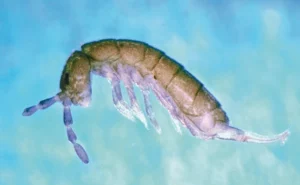Whenever you feel like you’re in a rut or unappreciated, remember that the work we do is extremely important.

as hexapods. PHOTO: SUSAN ELLIS, BUGWOOD.ORG
Evicting springtails
In the early 1970s, I applied for a job with a national pest management company. During the interview, the head entomologist handed me some small insects in a dish and asked me to identify them. They were springtails (Collembola) — no big deal, a beneficial hexapod, not a significant pest.
Then he threw a curveball at me, saying, “Young man, they are about to cause over $1 million worth of damage for an earthworm farmer who raises them in greenhouses. We have no idea what to do.”
I gulped and said, “I have a file on earthworms in my office, and I will look it up for you.”
Talk about a poker game. I had no idea what my file contained.
It offered helpful information. Commercially raised earthworms (Lumbricus terrestris) often peacefully co-exist with mites in their soil beds, or “worm bins.” When humid and rich soil conditions are just right, though, these secondary populations can explode in number and cause the worms to burrow deeply into the soil beds. Because the worms are not coming to the surface to feed, their growth and reproduction rates slow down. An overabundance of mites can decay much of the food the earthworms need and draw moisture from the exterior surface, so the situation continues to spiral.
Solution: The information in my file suggested using a light dusting of sulfur to knock down the mite population. After soaking the worm bin with water and causing the pests to surface, apply at the rate of 1/16 ounce of sulfur per square foot of the bin surface, it said. While sulfur should not harm the worms, it can increase the soil’s acidity and reduce the earthworm population.
Mind you, mites are arachnids. Springtails are hexapods. But with no other practical alternative seemingly available, I suggested they try the sulfur approach. “Before doing the entire crop of earthworms, try it on 10 to 20 worms. If that works, try it on an entire flat, then on one-third of all bins, and eventually the entire earthworm population.” It worked, even if the job offer didn’t.
Having Googled this situation in 2025, I was surprised to see this procedure is still recommended to remove heavy mite populations from earthworm beds. With new pesticide registration, you also can use this for springtails, provided the state registration allows the target site to be treated. Some states mandate the target pest must also be listed on the label.
Conclusion: Even beneficial insects can act as pests under certain environmental conditions. In such cases, necessity becomes the mother of invention. It’s good to know that what I tried six decades ago is still the state of the art!
You never know when you will run into a pest situation you never heard of before. When you do, do not determine what to do until you confirm with reasonable certainty that it will work.
Protecting patients
After a long day in the field, I received a call to rush to a hospital for an emergency: Phorids, or hump-backed flies, were crawling on patients in the burn unit.
I told the technician who called to gather whatever glue board traps he had and have them ready, along with some vinegar from the kitchen.
“But it’s flies, not mice,” he said.
“I know,” I replied. “Just do it and have someone ready to park my car.”
Solution: We added a few drops of vinegar to each open glue board and placed the boards near the patients on the floor and bed. I instructed the four nurses present to gently wave a cloth near each patient, creating a slight breeze that helped move the flies away from the wounds.
More from Dr. Frishman
- Persistence pays when seeking mosquito sources
- Use ULV wisely when targeting German cockroaches
- Creativity is crucial to catching ‘rogue roof rats’
<p>The post Protecting livelihoods and public health: The crucial role of PMPs first appeared on Pest Management Professional.</p>
from Pest Management Professional https://www.mypmp.net/protecting-livelihoods-and-public-health-the-crucial-role-of-pmps/
Sacramento CA
No comments:
Post a Comment